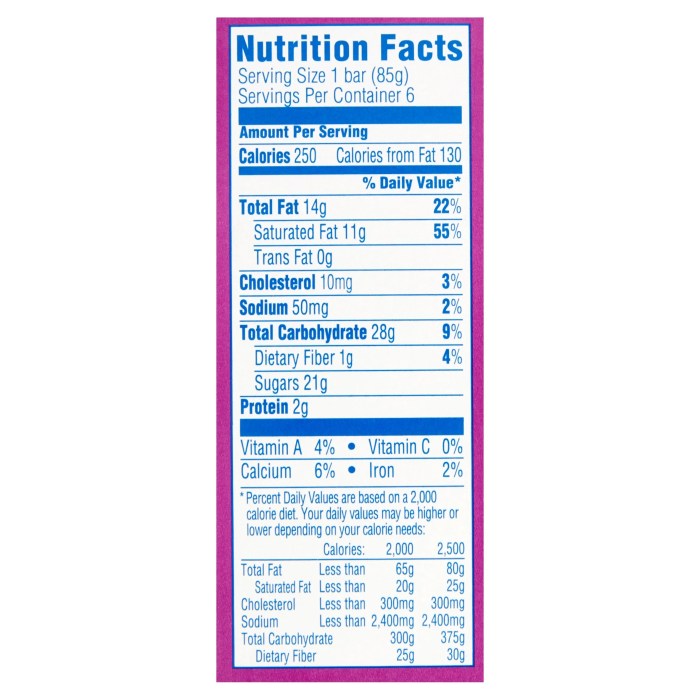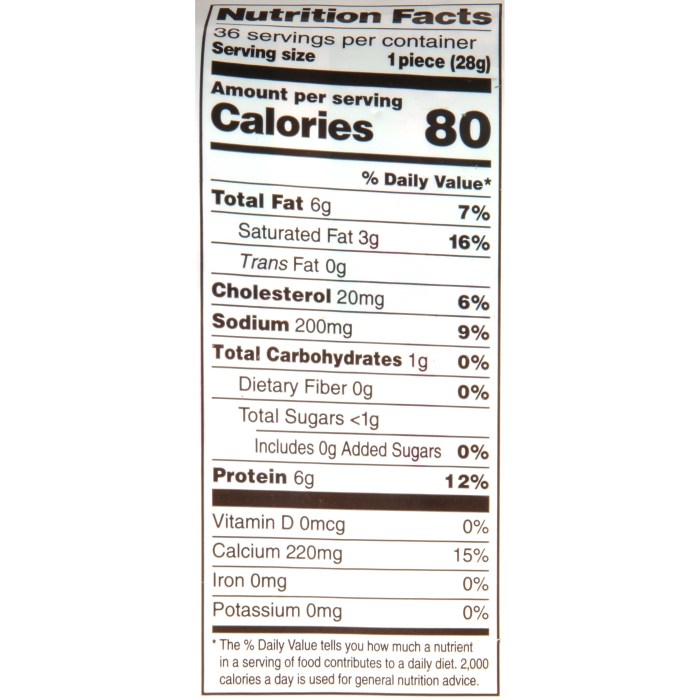Ingredient Examination: Klondike No Sugar Added Nutrition Facts

Klondike no sugar added nutrition facts – Unraveling the composition of Klondike No Sugar Added bars reveals a delicate dance of ingredients, each contributing to the final frozen delight. Understanding their individual roles and potential impacts on health provides a clearer picture of this seemingly simple treat.
The ingredients, carefully selected and measured, interact to create the familiar Klondike texture and taste, while aiming for a lower sugar profile. Let’s explore each component and its contribution to both the product and its potential effects on the consumer.
Dairy Ingredients
Dairy forms the foundation of the Klondike No Sugar Added bar, providing creaminess and richness. This typically includes components such as milk, cream, and possibly whey. Milk and cream contribute fat and protein, offering satiety and essential nutrients. However, high fat intake can contribute to weight gain if consumed in excess. Whey, a byproduct of cheesemaking, adds protein and can enhance texture.
The specific amounts of each dairy component will vary depending on the exact formulation, influencing the overall nutritional profile.
Hey there, fellow food explorers! Checking out Klondike no sugar added nutrition facts? It’s all about making smart choices, right? For a different breakfast perspective, you might also want to peep the nutritional info for something a bit heartier, like jimmy dean delight breakfast bowl nutrition facts , before deciding which better suits your healthy cravings.
Then, get back to those Klondike bars – they’re surprisingly refreshing!
Sweeteners
The “no sugar added” claim necessitates the use of alternative sweeteners. While specific ingredients vary by manufacturer and may change over time, common artificial sweeteners such as sucralose or acesulfame potassium are frequently employed in similar products. These sweeteners provide sweetness without the significant caloric impact of sugar. However, some studies have investigated potential long-term effects of artificial sweeteners on gut health and metabolism, although conclusive evidence remains a subject of ongoing research.
The absence of traditional sugars, however, does offer a lower glycemic impact compared to regular Klondike bars, potentially beneficial for individuals managing blood sugar levels.
Stabilizers and Emulsifiers
Various stabilizers and emulsifiers work in concert to maintain the desired texture and prevent separation of ingredients. These additives help create a smooth, consistent frozen treat. Common examples include guar gum, xanthan gum, and various types of lecithin. These ingredients are generally considered safe for consumption in the amounts typically used in processed foods, although individual sensitivities may exist.
Their primary function is to ensure a pleasant eating experience, not to contribute significantly to nutritional value.
Other Ingredients
Other ingredients, such as natural and artificial flavors, may be present to enhance the overall taste and aroma. These ingredients often remain unspecified due to proprietary formulations. The potential impacts of these ingredients vary greatly, depending on their specific chemical composition. Natural flavors, while seemingly healthier, can still contain trace amounts of allergens or other components that could potentially trigger adverse reactions in susceptible individuals.
Artificial flavors are subject to stringent regulatory standards, aiming to ensure their safety for consumption.
Health Implications & Considerations

Klondike No Sugar Added bars, while offering a tempting alternative to their sugary counterparts, present a complex nutritional landscape. Understanding their impact on health requires careful consideration of their ingredients and how they fit within a balanced dietary framework. A nuanced approach, balancing potential benefits with potential drawbacks, is key to informed consumption.The reduced sugar content of Klondike No Sugar Added bars is undoubtedly a positive aspect, aligning with dietary guidelines recommending a limitation on added sugars to promote better metabolic health and reduce the risk of chronic diseases like type 2 diabetes and heart disease.
However, the bars still contain significant amounts of fat, primarily saturated fat, which, in excess, can negatively impact cholesterol levels. The relatively high fat content contributes to the caloric density of the bars, necessitating mindful consumption to avoid unwanted weight gain. The protein and fiber content, while present, are not exceptionally high, meaning these bars shouldn’t be relied upon as a primary source of these essential nutrients.
Nutritional Alignment with Dietary Guidelines
The nutritional profile of Klondike No Sugar Added bars can be compared to established dietary recommendations. For instance, the reduced sugar content contributes positively to meeting guidelines for limiting added sugar intake, typically recommended to be less than 10% of total daily calories. However, the fat content, particularly saturated fat, needs careful consideration against recommended daily limits for saturated and total fat intake, often suggested to be below a certain percentage of daily calories.
The bar’s sodium content should also be considered in relation to daily sodium intake guidelines, which aim to prevent hypertension and related cardiovascular issues. A direct comparison of the Klondike bar’s nutritional facts with established daily recommended values allows for a personalized assessment of its suitability within an individual’s diet.
Incorporating Klondike No Sugar Added Bars into a Healthy Eating Plan
Integrating Klondike No Sugar Added bars into a healthy eating plan requires a conscious and balanced approach. They can be considered an occasional treat, not a staple food. To maintain a balanced diet, the bar could replace a less healthy dessert option or be consumed as a small part of a larger, well-balanced meal or snack that includes fruits, vegetables, and lean protein sources.
For example, a small portion of the bar could be paired with a handful of berries and a small amount of nuts, providing a more balanced and nutrient-rich snack. Regular consumption should be avoided, and the bar’s caloric and fat content should be factored into overall daily caloric intake to prevent weight gain.
Utilizing Nutritional Information for Informed Food Choices, Klondike no sugar added nutrition facts
The nutritional information provided on Klondike No Sugar Added bars serves as a valuable tool for making informed food choices. By carefully examining the serving size, calories, total fat, saturated fat, sugar, and sodium content, consumers can compare this information to other food options and assess its suitability within their individual dietary needs and goals. This empowers consumers to make conscious decisions, aligning their food choices with their health objectives.
For example, comparing the nutritional profile of the Klondike bar to other frozen desserts or snacks allows for a more informed decision, enabling consumers to choose the option that best aligns with their dietary restrictions or preferences.
Frequently Asked Questions
Are artificial sweeteners used in Klondike No Sugar Added bars?
Yes, Klondike No Sugar Added bars typically use artificial sweeteners to reduce the sugar content. The specific sweetener(s) used will be listed on the ingredient label.
How many servings are in a Klondike No Sugar Added bar box?
This varies depending on the package size. Check the packaging for the exact number of servings.
Are Klondike No Sugar Added bars suitable for people with diabetes?
While lower in sugar, they are still a processed food and should be consumed in moderation by individuals with diabetes. Always consult with your doctor or a registered dietitian for personalized dietary advice.
Can I find Klondike No Sugar Added bars in all stores?
Availability can vary depending on your location and retailer. Check your local grocery store or use the Klondike website’s store locator.



0